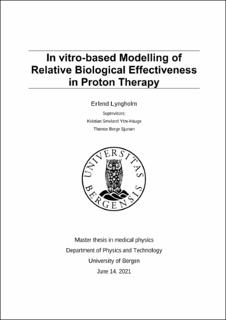| dc.description.abstract | Many cancer patients can benefit from proton therapy, as the treatment modality have been shown to provide a more conformal irradiation of the target while sparing surrounding healthy tissue, compared to photon therapy. The concept of the relative biological effectiveness allows for appliance of the large amount of experience from photon therapy when considering irradiation with protons. In proton therapy treatment today, a constant proton RBE of 1.1 relative to high-energy photons is applied, assuming protons to be 10% more effective for the same physical dose. However, the proton RBE have been shown to vary with multiple physical and biological factors including the deposited physical dose, irradiated tissue and radiation quality of the beam. Precise modelling of the proton RBE have therefore become an important field of study. This work presents a comprehensive analysis of proton RBE dependencies, using a large up-to date database of in vitro data points from proton irradiation experiments. The analysis focus on the RBE dependence on the reference radiation fractionation sensitivity ((α⁄β)_x), and the radiation quality of the beam, quantified by the linear energy transfer (LET). Additionally, potential differences between RBE of monoenergetic and broad energy proton beams (for a given average LET value) was explored, and the effects of variations in the data selection procedure were investigated. The widely used assumption of an inverse proportionality of RBE with (α⁄β)_x was investigated through linear fitting and the fits were compared with previous published models applying this assumption. The RBE-LET relationship was investigated by fitting of polynomials from 1st to 4th degree and polynomials of 1st and 2nd degree in combination with exponential functions. Additional fitting was performed on different restricted databases in terms of reduced range of included LET and (α⁄β)_x values. Furthermore, the database was seen to be highly imbalanced, i.e. data points were not evenly distributed over the (α⁄β)_x and LET range, and fitting was therefore also performed using an iterative sampling procedure to compensate for this. Selected regression fits were implemented as RBE models and the RBE estimates from these, both as a function of LET, dose and (α⁄β)_x and for a simulated spread out Bragg peak (SOBP) scenario were compared to the estimates of three published RBE models. Linear fitting on both the unrestricted and restricted databases showed a trend of a steeper increase in RBE with increasing LET when an SOBP beam is used, compared to applying a monoenergetic beam. Analysis of the (α⁄β)_x dependency implied that appliance of the 〖1/(α⁄β)〗_x assumption might lead to overestimated RBE at (α⁄β)_x values below approximately 6 Gy, and underestimated RBE predictions for higher (α⁄β)_x. Therefore, a less strong dependency of (α⁄β)_x for the proton RBE should be considered further. Fitting on restricted databases showed that the model output is largely affected by the included LET values in the model database, as lowering the upper limit of included LET values resulted in a smaller slope in the applied linear RBE-LET relationship, indicating a non-linear relationship. Fitting on a balanced database in terms of (α⁄β)_x largely affected the fitting output. It is however debatable whether the applied procedure is optimal, as some of the data points in regions with fewer data might be assigned too large weights in the fitting. Non-linear fitting generally yielded better performance than linear fitting on the database, although the differences were marginal, and a linear dependency could not be rejected. The quartic fitting function, f_LQCq, was implied to best model the data, and comparable performance was indicated for the fitting functions f_LQ, f_LQC, f_LE and f_LQE. Implementing three of the linear models and the f_LQCq and f_LQC models from this work in a SOBP scenario, all models gave RBE estimates that largely disagreed with a constant RBE=1.1. All the considered models showed only small differences from a constant RBE=1.1 in the entrance region. The models deviated more from each other at the proximal part of the SOBP, and all models predicted an increasing RBE across the SOBP. The RBE increase given by the f_LQC model was steeper than the other models, and although the f_LQCq model was above this model at the proximal part of the SOBP, the f_LQC model gave higher RBE estimates than the f_LQCq model at the distal end of the SOBP. The RBE estimates of the linear model obtained with data having all values of LET generally gave higher RBE estimates than the two linear models obtained with stricter restrictions on both LET and (α⁄β)_x. The analyses of the present work showed that database selection and regression procedure largely affects the outcome of RBE modelling. This can explain the observed differences between previously published RBE models. | |
